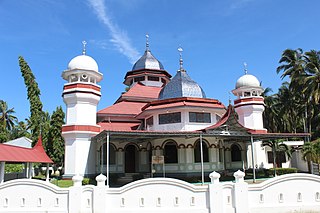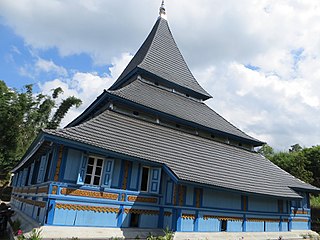
Minangkabau people, also known as Minang, are an Austronesian ethnic group native to the Minangkabau Highlands of West Sumatra, Indonesia. The Minangkabau's West Sumatera homelands was the seat of the Pagaruyung Kingdom, believed by early historians to have been the cradle of the Malay race, and the location of the Padri War.

The Padri War was fought from 1803 until 1837 in West Sumatra, Indonesia between the Padri and the Adat. The Padri were Muslim clerics from Sumatra who wanted to impose Sharia in Minangkabau in West Sumatra, Indonesia. The Adat comprised the Minangkabau nobility and traditional chiefs. They asked for the help of the Dutch, who intervened in 1821 and helped the nobility defeat the Padri faction.

West Sumatra is a province of Indonesia. It is on the west coast of the island of Sumatra and includes the Mentawai Islands off that coast. West Sumatra borders the Indian Ocean to the west, as well as the provinces of North Sumatra to the north, Riau to the northeast, Jambi to the southeast, and Bengkulu to the south. The province has an area of 42,119.54 km2 (16,262.45 sq mi), or about the same size as Switzerland, with a population of 5,534,472 at the 2020 census. The official estimate at mid 2023 was 5,757,210. The province is subdivided into twelve regencies and seven cities. It has relatively more cities than other provinces outside Java, although several of them are relatively low in population compared with cities elsewhere in Indonesia. Padang is the province's capital and largest city.

Padang is the capital and largest city of the Indonesian province of West Sumatra. It had a population of 833,562 at the 2010 Census and 909,040 at the 2020 Census; the official estimate as at mid 2023 was 942,938 - comprising 473,089 males and 469,849 females. It is the 16th most populous city in Indonesia and the most populous city on the west coast of Sumatra. The Padang metropolitan area is the third most populous metropolitan area in Sumatra with a population of over 1.7 million. Padang is widely known for its Minangkabau culture, cuisine, and sunset beaches.

Payakumbuh is the second largest city in West Sumatra province, Indonesia, with a population of 116,825 at the 2010 Census and 139,576 at the 2020 Census; the official estimate as at mid 2023 was 144,830 - comprising 72,840 males and 71,990 females. It covers an area of 80.42 km² and is in the Minangkabau Highlands, 120 km by road from the West Sumatran capital city of Padang and 180 km from the Riau capital city of Pekanbaru.

Pagaruyung, also known as Pagarruyung, Pagar Ruyung and Malayapura or Malayupura, was a kingdom that once stood in the island of Sumatra and the seat of the Minangkabau kings of Western Sumatra. Modern Pagaruyung is a village in Tanjung Emas subdistrict, Tanah Datar regency, located near the town of Batusangkar, Indonesia.

The Ganting Grand Mosque is a Sunni mosque located in Ganting, Padang, West Sumatra, Indonesia. Construction began in 1805, making it the oldest in Padang and one of the oldest in Indonesia. It is a Cultural Property of Indonesia.

The Syekh Burhanuddin Grand Mosque is one of the oldest mosques as well as a cultural heritage in West Sumatra, Indonesia. The mosque is located in Nagari Ulakan, Ulakan Tapakis sub-district, Padang Pariaman district of West Sumatra.

Rao Rao Mosque is one of the oldest mosques in Indonesia located in Nagari Rao Rao, Tarab River, Tanah Datar Regency, West Sumatra. It is located on the road from Batusangkar bound to Bukittinggi, precisely in Rao Rao. This mosque of Minangkabau and Persian architecture was built in 1908 with a roof made from fibers before being changed to zinc.

The Bingkudu Mosque is one of the oldest mosques in Indonesia. It was founded by the Padri in the wake of the Padri War in West Sumatra in 1823. This mosque with typical Minangkabau style architecture is located in Jorong Bingkudu, Nagari Canduang Koto Laweh, Canduang District, Agam Regency, West Sumatra. When it was first built, the building of the mosque was made of wood on its floor, pole, and wall.

Jamik Sungai Jambu Mosque is one of the oldest mosques in Indonesia located in Jorong Sungai River, Sungai Jambu Nagari, Pariangan District, Tanah Datar Regency, West Sumatra. The mosque was built in 1918 at the foot of Mount Marapi, and during its development it has experienced a number of improvements both in terms of outlook and management. The mosque had ranked first for several times including in 2012, in the assessment of environmentally-oriented mosques for the provincial level which is conducted by the Indonesian Mosque Council.

Koto Baru Grand Mosque is one of the oldest mosques in Indonesia located in Koto Baru Nagari, Sungai Pagu District, South Solok Regency, West Sumatra.
Mutaqaddimin Mosque is an old mosque in Indonesia, located in Jorong Kapalo Tangah, Andaleh Nagari, Luhak District, Lima Puluh Kota Regency, West Sumatra. The mosque was built in 1930, making it the oldest mosque in Andaleh Nagari area.

The Tuo Koto Nan Ampek Mosque, also known as Gadang Balai Nan Duo Mosque is one of the oldest mosques in Indonesia located in Koto Nan Ampek Nagari, now administratively included into the area of Balai Nan Duo village, West Payakumbuh District, city of Payakumbuh, West Sumatera. The Minangkabau architecture is thought to have been built in 1840 which was originally covered with fiber roofs before being replaced with zinc. Currently, other than being used for Muslim worship activities, this single-level mosque is also used by the surrounding community as a means of religious education.

The Nurul Huda Mosque is one of the oldest mosques in Indonesia, located in Baringin District, Sawahlunto, West Sumatra. The mosque, built during the Dutch occupation, has a rectangular building with a tower blending into the main building. Currently, in addition to a function as a place of worship for Muslims, this two-story mosque is also used as a means of religious education for the surrounding community.

Islam is the most common religion in the Indonesian province of West Sumatra, embraced by 97.42% of the population. The Muslim population increases to 99.6% if it excludes the Mentawai Islands, where the majority of the non-Muslim (Protestant) West Sumatrans reside. Islam in West Sumatra is predominantly Sunni, though there is a small Shia Islamic pocket within the coastal city of Pariaman. The Minangkabau people, indigenous to West Sumatra, comprise 88% of the West Sumatran population today and have historically played an important role within Indonesia's Muslim community. Up until today, the region is considered one of the strongholds of Islam in Indonesia.

Minangkabau culture is the culture of the Minangkabau ethnic group in Indonesia, part of the Indonesian culture. This culture is one of the two major cultures in the Indonesian archipelago which is very prominent and influential.

Marawa is a tricolour flag that consists of three vertical charts that feature the colours of the Minangkabau culture: black, red, and gold. It is not known for sure when this flag was first used, but it was officially adopted as the flag of the Pagaruyung Kingdom since its founding in 1347. This flag was also adopted by other kingdoms of the Minangkabau rantau such as the Inderapura Kingdom. A derivative of the flag is also currently used by Negeri Sembilan, a state in Malaysia with historical and cultural connections with the kingdom.




























